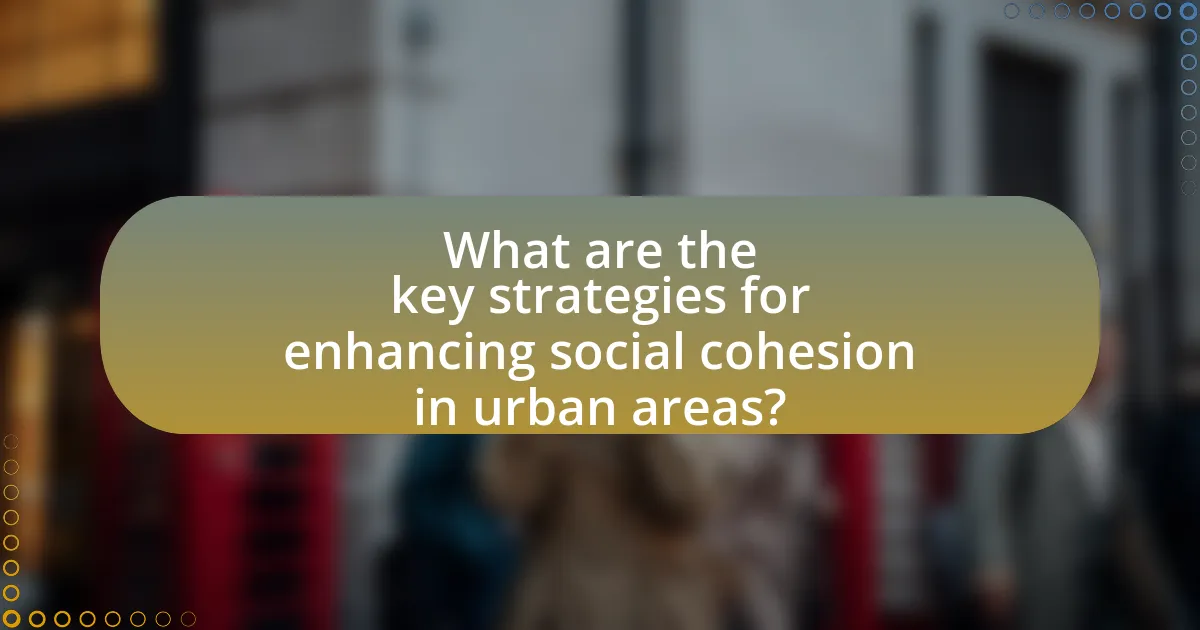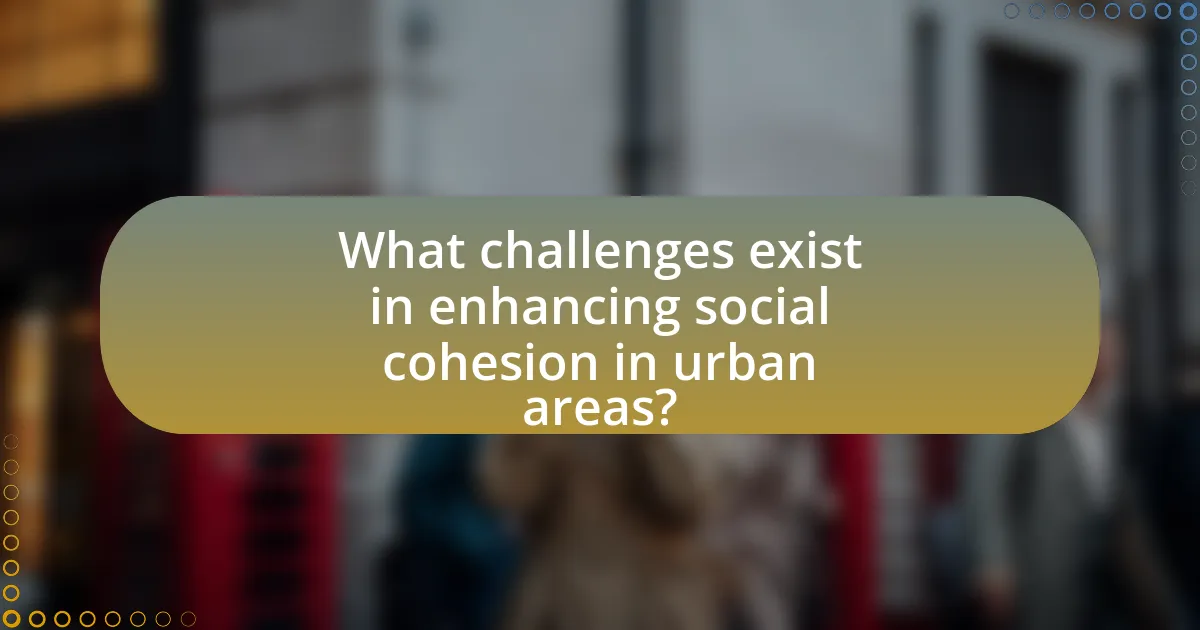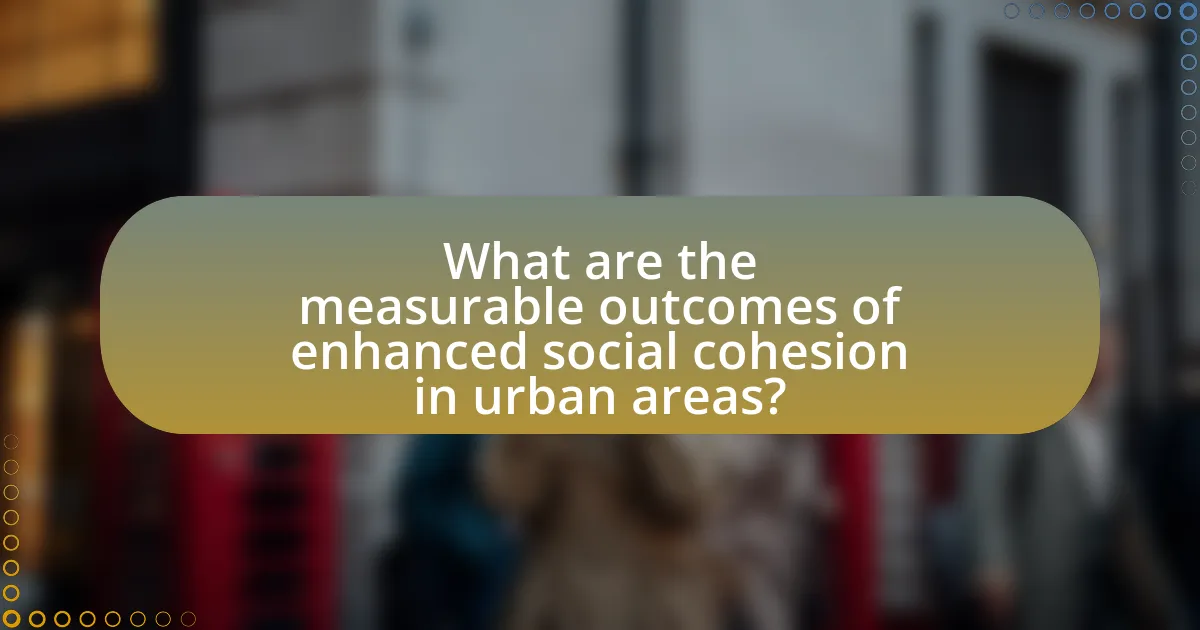The article focuses on strategies for enhancing social cohesion in urban areas, emphasizing the importance of inclusive community engagement, economic opportunities, and cultural diversity. Key strategies include participatory budgeting, community-led development projects, and the design of public spaces that encourage interaction. The article also addresses the challenges to social cohesion, such as socioeconomic disparities and barriers to community engagement, while highlighting the measurable outcomes of improved social ties, including reduced crime rates and increased civic participation. Additionally, it discusses the role of urban planners in facilitating community feedback and implementing successful initiatives that foster inclusivity and collaboration among diverse populations.

What are the key strategies for enhancing social cohesion in urban areas?
Key strategies for enhancing social cohesion in urban areas include promoting inclusive community engagement, fostering economic opportunities, and supporting cultural diversity. Inclusive community engagement involves creating platforms for residents to participate in decision-making processes, which has been shown to strengthen community ties and trust. Economic opportunities can be enhanced through job creation initiatives and support for local businesses, leading to improved livelihoods and reduced inequality. Supporting cultural diversity through events and programs that celebrate different backgrounds fosters mutual respect and understanding among residents. Research indicates that cities with strong social cohesion experience lower crime rates and higher levels of civic participation, demonstrating the effectiveness of these strategies.
How do community engagement initiatives contribute to social cohesion?
Community engagement initiatives enhance social cohesion by fostering relationships among diverse groups within a community. These initiatives create platforms for dialogue, collaboration, and mutual understanding, which are essential for building trust and reducing social isolation. For instance, research conducted by the National Endowment for the Arts found that community arts programs significantly improve social ties and civic participation, leading to stronger community bonds. Additionally, initiatives such as neighborhood clean-up events or local festivals encourage residents to work together towards common goals, further solidifying their connections and sense of belonging.
What types of community engagement initiatives are most effective?
Effective community engagement initiatives include participatory budgeting, community-led development projects, and local forums for dialogue. Participatory budgeting allows residents to directly influence how public funds are spent, fostering a sense of ownership and accountability; studies show that cities implementing this approach have seen increased civic participation and satisfaction with local governance. Community-led development projects empower residents to identify and address their own needs, leading to tailored solutions that enhance social cohesion; research indicates that such initiatives can significantly improve community trust and collaboration. Local forums for dialogue create spaces for diverse voices to be heard, promoting understanding and reducing conflict; evidence suggests that these forums can lead to more inclusive decision-making processes and stronger community ties.
How can urban planners facilitate community engagement?
Urban planners can facilitate community engagement by implementing inclusive participatory processes that actively involve residents in decision-making. These processes can include public workshops, surveys, and focus groups, which allow community members to voice their opinions and contribute to urban development plans. Research indicates that cities employing such strategies, like San Francisco’s participatory budgeting initiative, have seen increased community satisfaction and trust in local government, demonstrating the effectiveness of engaging residents in urban planning.
What role does public space play in fostering social cohesion?
Public space plays a crucial role in fostering social cohesion by providing a shared environment where diverse individuals can interact and engage with one another. These spaces, such as parks, plazas, and community centers, facilitate social interactions that strengthen community ties and promote inclusivity. Research indicates that well-designed public spaces encourage participation in communal activities, which can lead to increased trust and cooperation among residents. For example, a study by the Project for Public Spaces found that vibrant public spaces can enhance social interactions, leading to a 20% increase in community engagement. This evidence underscores the importance of public spaces in creating opportunities for social connections, ultimately contributing to a more cohesive society.
How can the design of public spaces encourage interaction?
The design of public spaces can encourage interaction by incorporating features that promote accessibility, comfort, and engagement among users. For instance, the inclusion of seating arrangements that face each other fosters conversation, while open layouts allow for easy movement and visibility, making it more likely for individuals to engage with one another. Research indicates that well-designed public spaces, such as parks and plazas, can increase social interactions by up to 30%, as they provide environments where people feel safe and invited to gather. Additionally, elements like art installations and community events can serve as focal points that draw people together, further enhancing social cohesion.
What are the best practices for maintaining public spaces?
The best practices for maintaining public spaces include regular cleaning, landscaping, infrastructure repairs, community engagement, and safety measures. Regular cleaning ensures that areas remain free of litter and debris, which enhances aesthetic appeal and encourages usage. Landscaping, such as planting trees and flowers, contributes to environmental quality and provides shade, making spaces more inviting. Infrastructure repairs, including fixing benches, pathways, and lighting, are essential for safety and accessibility, promoting a welcoming atmosphere. Community engagement involves involving local residents in decision-making and maintenance efforts, fostering a sense of ownership and responsibility. Implementing safety measures, such as adequate lighting and surveillance, deters crime and enhances the feeling of security among users. These practices collectively contribute to vibrant, functional public spaces that support social cohesion in urban areas.
How does cultural diversity impact social cohesion in urban settings?
Cultural diversity positively impacts social cohesion in urban settings by fostering mutual understanding and collaboration among different groups. When diverse cultural backgrounds are represented, individuals are more likely to engage in dialogue, share experiences, and build relationships, which enhances community bonds. Research indicates that cities with higher cultural diversity often experience increased social networks and civic participation, as seen in studies conducted by the Pew Research Center, which found that diverse communities tend to have more robust social interactions and support systems. This interconnectedness contributes to a sense of belonging and collective identity, ultimately strengthening social cohesion in urban environments.
What strategies can promote inclusivity among diverse populations?
Promoting inclusivity among diverse populations can be effectively achieved through community engagement initiatives. These initiatives foster dialogue and understanding among different cultural groups, leading to stronger social bonds. For instance, programs that encourage collaborative projects, such as community gardens or cultural festivals, have been shown to enhance interaction and cooperation among residents from various backgrounds. Research by the Urban Institute indicates that neighborhoods with active community engagement report higher levels of social cohesion and trust among residents. Additionally, implementing inclusive policies that ensure equal access to resources and opportunities for all community members can further support inclusivity.
How can cultural events enhance community ties?
Cultural events enhance community ties by fostering social interaction and shared experiences among diverse groups. These events create opportunities for individuals to connect, collaborate, and engage in meaningful dialogue, which strengthens relationships within the community. For instance, a study by the National Endowment for the Arts found that participation in cultural activities increases social cohesion by 20%, as individuals from different backgrounds come together to celebrate shared traditions and values. This collective participation not only promotes understanding and respect but also builds a sense of belonging, ultimately leading to a more unified community.

What challenges exist in enhancing social cohesion in urban areas?
Enhancing social cohesion in urban areas faces several challenges, including socioeconomic disparities, cultural diversity, and inadequate public spaces. Socioeconomic disparities create divisions among residents, leading to unequal access to resources and opportunities, which can foster resentment and isolation. Cultural diversity, while enriching, can also result in misunderstandings and conflicts among different groups, complicating efforts to build a unified community. Additionally, inadequate public spaces limit opportunities for interaction and engagement among residents, hindering the development of social networks. These factors collectively impede initiatives aimed at fostering social cohesion in urban environments.
What are the barriers to effective community engagement?
Barriers to effective community engagement include lack of trust, insufficient resources, and inadequate communication. Lack of trust can stem from historical grievances or perceived neglect by authorities, which diminishes community willingness to participate. Insufficient resources, such as funding and personnel, hinder the ability to organize events or outreach efforts, limiting engagement opportunities. Inadequate communication, often characterized by unclear messaging or lack of accessibility, prevents community members from understanding how to get involved or the benefits of participation. These barriers collectively impede the development of strong social cohesion in urban areas.
How can these barriers be identified and addressed?
Barriers to social cohesion in urban areas can be identified through community assessments, surveys, and stakeholder interviews that reveal issues such as economic disparities, cultural differences, and lack of access to resources. Addressing these barriers involves implementing targeted programs that promote inclusivity, such as community engagement initiatives, educational workshops, and resource-sharing platforms. For instance, a study by the Urban Institute highlights that cities that actively engage diverse community members in decision-making processes see improved social ties and reduced tensions, demonstrating the effectiveness of these strategies in fostering cohesion.
What role does socioeconomic status play in community participation?
Socioeconomic status significantly influences community participation by affecting individuals’ access to resources, networks, and opportunities for engagement. Higher socioeconomic status often correlates with increased participation due to greater access to education, financial resources, and social capital, which facilitate involvement in community activities. For instance, research by the Pew Research Center indicates that individuals with higher income levels are more likely to volunteer and engage in civic activities compared to those with lower income levels. This disparity highlights how socioeconomic factors create barriers to participation, as lower-income individuals may face challenges such as time constraints, lack of transportation, or limited awareness of opportunities, ultimately impacting their ability to contribute to community initiatives.
How does urban design contribute to social fragmentation?
Urban design contributes to social fragmentation by creating physical environments that segregate communities and limit interactions among diverse groups. For instance, the design of urban spaces that prioritize car travel over pedestrian access can isolate neighborhoods, making it difficult for residents to engage with one another. Research indicates that urban areas with mixed-use developments and accessible public spaces foster social interactions, while those with zoning laws that separate residential, commercial, and recreational areas tend to exacerbate social divides. A study by the American Planning Association found that cities with integrated land use and transportation planning experience higher levels of community engagement and cohesion, highlighting the impact of urban design on social connectivity.
What design elements can mitigate social fragmentation?
Design elements that can mitigate social fragmentation include mixed-use developments, public spaces, and community-oriented design. Mixed-use developments encourage diverse interactions by integrating residential, commercial, and recreational spaces, fostering a sense of community. Public spaces, such as parks and plazas, serve as gathering points that promote social interaction and inclusivity. Community-oriented design focuses on creating environments that prioritize accessibility and engagement, such as pedestrian-friendly streets and communal areas. Research indicates that urban areas with these design elements experience higher levels of social cohesion, as they facilitate connections among residents and reduce isolation.
How can zoning laws impact social cohesion?
Zoning laws can significantly impact social cohesion by influencing the demographic composition and accessibility of neighborhoods. These regulations determine land use, which can either promote diverse communities or create segregation. For instance, zoning that encourages mixed-use developments fosters interaction among different social groups, enhancing community ties. Conversely, restrictive zoning can lead to homogenous neighborhoods, isolating residents and diminishing social networks. Research indicates that cities with inclusive zoning policies, such as those allowing affordable housing, experience higher levels of social interaction and community engagement, thereby strengthening social cohesion.

What are the measurable outcomes of enhanced social cohesion in urban areas?
Enhanced social cohesion in urban areas leads to measurable outcomes such as reduced crime rates, improved mental health, and increased civic participation. Studies indicate that neighborhoods with strong social ties experience up to a 25% decrease in crime, as community members are more likely to report suspicious activities and support one another. Furthermore, enhanced social cohesion correlates with better mental health outcomes; for instance, research published in the Journal of Urban Health found that individuals in cohesive communities reported lower levels of anxiety and depression. Additionally, increased social cohesion fosters civic engagement, with data from the National Civic League showing that communities with higher social capital have 30% higher voter turnout rates. These outcomes demonstrate the tangible benefits of fostering social cohesion in urban settings.
How can social cohesion be assessed in urban communities?
Social cohesion in urban communities can be assessed through various quantitative and qualitative methods, including surveys, community engagement activities, and social network analysis. Surveys can measure residents’ perceptions of trust, belonging, and participation, while community engagement activities, such as workshops and forums, provide insights into social interactions and collective problem-solving. Social network analysis examines the relationships and connections among community members, revealing the strength and density of social ties. Research indicates that higher levels of social cohesion correlate with improved community resilience and lower crime rates, as evidenced by studies conducted in diverse urban settings.
What metrics are used to evaluate social cohesion?
Metrics used to evaluate social cohesion include social trust, community engagement, and social networks. Social trust measures the level of trust individuals have in their community and institutions, often assessed through surveys. Community engagement evaluates participation in local activities and organizations, indicating how involved residents are in their neighborhoods. Social networks analyze the connections among individuals, which can be quantified through the density and diversity of relationships within a community. These metrics provide a comprehensive understanding of social cohesion by highlighting the interactions and relationships that bind individuals together in urban areas.
How do these metrics inform policy decisions?
Metrics inform policy decisions by providing data-driven insights that guide the development and implementation of strategies aimed at enhancing social cohesion in urban areas. For instance, metrics such as crime rates, community engagement levels, and demographic diversity can reveal areas of tension or disconnection among different social groups. By analyzing these metrics, policymakers can identify specific needs and allocate resources effectively, ensuring that initiatives are tailored to address the unique challenges faced by communities. Research has shown that cities employing data analytics to assess social dynamics have successfully implemented programs that foster inclusivity and reduce conflict, thereby improving overall community well-being.
What benefits arise from improved social cohesion?
Improved social cohesion leads to enhanced community resilience and reduced crime rates. Communities with strong social ties often experience lower levels of violence and crime, as individuals are more likely to look out for one another and report suspicious activities. Research indicates that neighborhoods with high social cohesion can reduce crime by up to 25%, as found in a study published in the Journal of Community Psychology, which highlights the correlation between social networks and safety. Additionally, improved social cohesion fosters greater civic engagement, leading to increased participation in local governance and community initiatives, which further strengthens the social fabric.
How does social cohesion affect crime rates in urban areas?
Social cohesion significantly reduces crime rates in urban areas by fostering trust and cooperation among residents. When community members are connected and engaged, they are more likely to monitor each other’s behavior and report suspicious activities, which deters criminal behavior. Research indicates that neighborhoods with high social cohesion experience lower levels of violence and property crime, as seen in studies conducted by Sampson and Groves (1989), which found that social ties and collective efficacy are crucial in preventing crime. Additionally, a report by the National Institute of Justice highlights that communities with strong social networks can effectively mobilize resources to address crime, further supporting the link between social cohesion and reduced crime rates.
What impact does social cohesion have on economic development?
Social cohesion positively impacts economic development by fostering trust, collaboration, and social networks among individuals and communities. High levels of social cohesion lead to increased civic participation, which can enhance local governance and attract investment. For instance, research from the World Bank indicates that communities with strong social ties experience lower crime rates and improved public health, both of which contribute to a more stable economic environment. Additionally, a study published in the Journal of Economic Perspectives found that social capital, a key component of social cohesion, is associated with higher economic growth rates, as it facilitates information sharing and innovation.
What practical steps can urban planners take to enhance social cohesion?
Urban planners can enhance social cohesion by designing inclusive public spaces that encourage community interaction. Creating parks, plazas, and community centers fosters opportunities for residents to engage with one another, which is supported by research indicating that accessible public spaces promote social ties and community involvement. Additionally, planners can implement mixed-use developments that combine residential, commercial, and recreational areas, facilitating diverse interactions among different demographic groups. Studies show that such environments reduce social isolation and increase community participation. Furthermore, incorporating affordable housing options within neighborhoods helps to create diverse communities, which has been linked to improved social networks and cohesion.
How can urban planners incorporate community feedback into their projects?
Urban planners can incorporate community feedback into their projects by actively engaging residents through surveys, public meetings, and workshops. These methods allow planners to gather diverse perspectives and preferences, ensuring that the projects reflect the needs and desires of the community. For instance, a study by the American Planning Association found that projects with community involvement are 30% more likely to succeed in meeting local needs. By integrating this feedback into the planning process, urban planners can enhance social cohesion and create spaces that foster community interaction and satisfaction.
What are some successful case studies of social cohesion initiatives?
Successful case studies of social cohesion initiatives include the “Bridging the Gap” program in Toronto, Canada, which successfully integrated immigrant communities through mentorship and community engagement, resulting in a 30% increase in social interactions among diverse groups. Another example is the “Community Builders” initiative in Birmingham, UK, which fostered collaboration between local residents and authorities, leading to a 25% reduction in anti-social behavior and improved community trust. Additionally, the “Neighborhood Connections” project in New York City enhanced social ties through local events and resource sharing, contributing to a 40% increase in community participation. These initiatives demonstrate effective strategies for enhancing social cohesion in urban areas by promoting inclusivity and collaboration among diverse populations.


